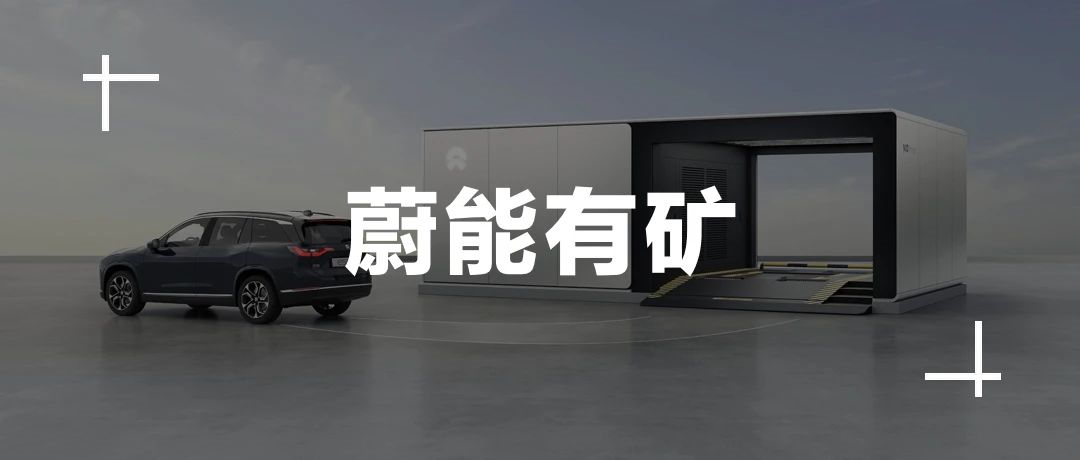Author: A Green Leaf
The last time WmAuto appeared in public view was due to a bearish report, which described WmAuto as a subsidiary of NIO and claimed that its function was only to create false revenue.
I want to say that this is underestimating WmAuto.
WmAuto’s expectation for itself is to be a comprehensive solution provider for BAAS services.
To understand this concept, we must first understand the company “WmAuto” and why we call WmAuto a “mine”.
WmAuto is not a subsidiary of NIO at all
Currently, the market’s understanding of “WmAuto” is mainly due to its role as the operator of BAAS.
After Li Bin proposed the BAAS plan of “separation of vehicle and electricity, battery rental, and recharging and upgrading” in 2020, there has been continuous debate and misunderstanding about BAAS.
The most common misunderstanding is that NIO collects the monthly rent of BAAS.
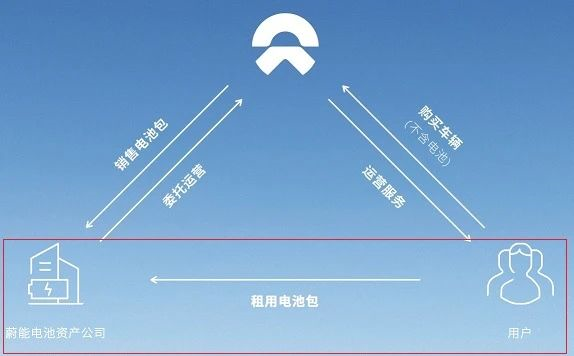
This is obviously not the case, as Li Bin clearly stated in the press conference that “NIO is only the collection agent, and the money should be paid to WmAuto.”
The second, and the biggest misunderstanding, is that “WmAuto is a subsidiary of NIO” and its function is to beautify the NIO financial report.
The bear report attacked NIO on this basis.
WmAuto’s business is based on NIO’s BAAS, so in terms of management, Shen Fei, who manages energy, serves as chairman and Lu Ronghua, who manages battery operation, serves as general manager.
No one knows BAAS better than NIO, as it is a completely new battery business model, so it is responsible for its shareholders to have the pioneers in charge.
However, NIO only manages the personnel rights of administrative operations, and the personnel rights related to finance do not belong to NIO.
The reason is simple: WmAuto is not a subsidiary of NIO at all.
Evolutionary history of WmAuto’s equity structure
WmAuto originally had four major shareholders: NIO, CATL, Hubei KEVC, and Guotai Junan (each holding 25%).
After several rounds of capital increase, the company’s equity structure has become quite complicated.
However, if we look at the distribution of the industry among the original four major shareholders from another perspective, the distribution of WmAuto’s equity industry has not changed much.
The four initiating shareholders are:
- Car company: NIO
- Supply chain: CATL- Financial Institution: Guotai Junan
- Local State-Owned Assets: Hubei Science and Technology Investment
- Current ownership structure:
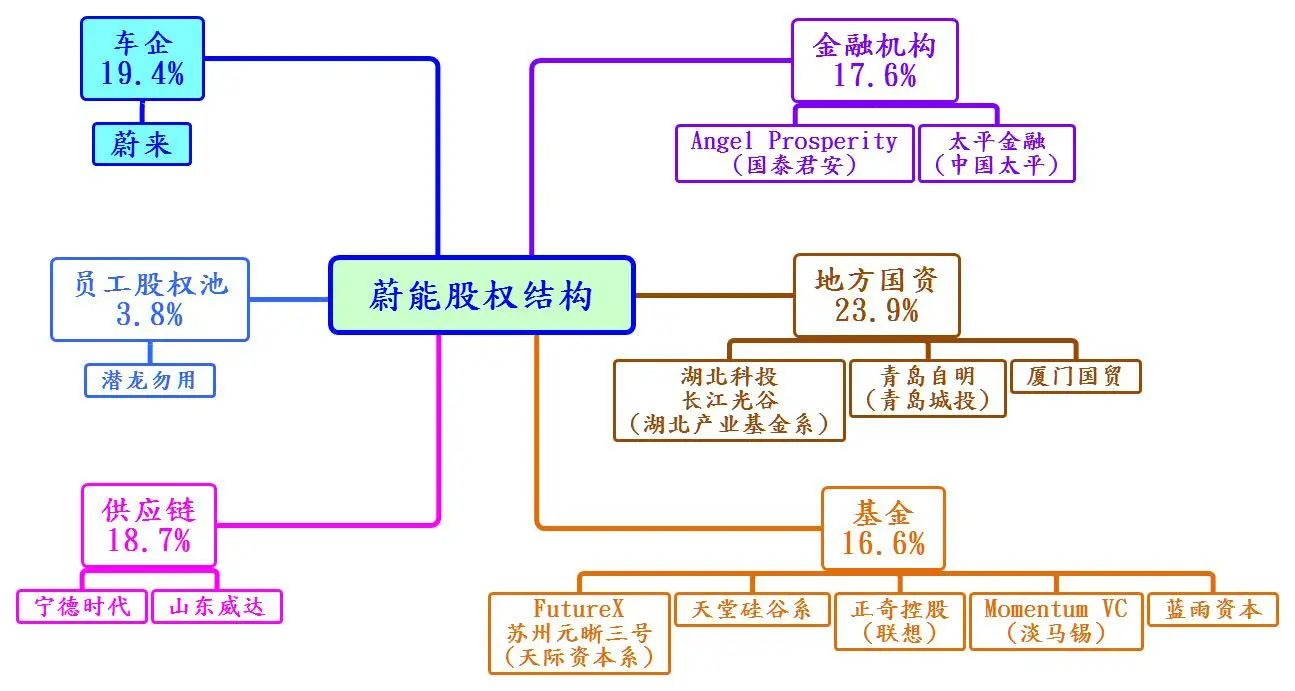
Evolution of equity ownership
Car Manufacturer: NIO
After several rounds of capitalization dilution, NIO’s equity ownership is now below 20%. It is believed that those who think NIO is a wholly-owned subsidiary of NIO Holding are simply mistaken, since NIO has not been a controlling shareholder of NIO from the very beginning of NIO Holding.
At NIO Power Day in 2021, Qin Lihong said that NIO’s battery swap system is open to the entire industry, and there has been an increasing number of players using it over the past year.
However, NIO Holding still has only one shareholder in the automotive industry, while other battery swap players have chosen to follow suit and create their own battery banks instead of joining NIO.
“Qianlong Wuyong Company” is controlled by NIO and run by Lu Ronghua. It is a stock incentive platform established after Series A funding, with the right to dividends and liquidation distribution, but no voting rights.
Supply Chain: CATL
CATL is NIO’s battery supplier and therefore a natural shareholder of NIO Holding.
In the subsequent rounds of capitalization, CATL did not participate mainly because it had established EVOGO, which is responsible for its commercial vehicle battery swap business, and was cooperating with many carmakers to unify the standards of commercial vehicle battery swap.
In addition to NIO Holding, CATL has also invested in JNNEV, a joint venture with SAIC, CNPC, and Sinopec, to launch its first vehicle, RisingAuto R7, on its battery swap platform. After that, many of SAIC’s electric vehicle models will join the same platform.
CATL is involved in almost all aspects of the battery swap field, and NIO Holding is just one of its many investments.
Shandong Weida is NIO’s supplier of battery swap machinery. After the first round of capitalization, it purchased shares in NIO Holding, and subsequently, due to limited company funds, it was unable to participate in the subsequent rounds of capitalization.
Financial Institution: Guotai Junan
Guotai Junan is, as Li Bin said at the BAAS conference, “waiting to help us issue ABS and asset management products in the future.”
In other words, introducing financial institutions is to prepare for the securitization of battery assets in the future.
Battery operation is a capital-intensive business that requires the support of financial institutions. Guotai Junan is a good fit for this position. Later, NIO Holding issued battery ABS and ABS, which may have been assisted by Guotai Junan.“`
Guotai Junan transferred NIO’s equity to its subsidiary Angel Prosperity Investment HK I Limited and slightly increased the share capital, becoming the second largest shareholder after NIO.
Another financial institution investing in the BAAS is Taiping Financial under China Taiping Insurance Group, which is responsible for battery insurance. If BAAS users do not purchase worry-free services, they are required to pay an additional battery insurance fee of RMB 80 per month. NIO will purchase insurance for BAAS batteries, and the damage will be covered by the insurance company as long as the user does not intentionally damage the batteries.
As Lu Ronghua mentioned, “quality belongs to quality, and insurance belongs to insurance.” Quality issues are the responsibility of the battery supplier, while accidental accidents are covered by insurance.
NIO’s battery insurance is underwritten by multiple companies, with China Taiping being one of them.
Local State-owned Enterprise: Hubei Kechuang Investment
Hubei Kechuang Investment had invested in NIO before it went public. The two jointly established Wuhan NIO Energy Co., Ltd. in 2017, which is the headquarters of NIO’s energy business.
Therefore, when NIO was to establish its headquarters, Wuhan was the right choice, and Hubei Kechuang Investment became NIO’s initiating shareholder.
Since Hubei Kechuang Investment had experience in co-managing with NIO before the establishment of NIO, the financial director of NIO was appointed by Hubei Kechuang Investment rather than NIO.
When Grizzly bear mentioned that NIO’s revenue was inflated, the financial director was the first to cross this hurdle. Hubei Kechuang Investment did not have the motivation to help NIO falsify, and NIO was not a one-man show.
In addition to Hubei Kechuang Investment, the list of new investors also includes Changjiang Guangxinyuan New Energy Industry Investment Fund, jointly initiated by Changjiang Industry Fund and NIO Automobile.
At the same time as Shandong Weida increased its capital, there was also Qingdao Ziming and Xing Equity Investment Partnership Enterprise, which is affiliated with Qingdao Urban Investment.
The Xiamen Guomao Industrial Development Equity Investment Partnership Enterprise was initiated by Xiamen Guomao Group, which increased its capital at the same time as Changjiang Guanggu.
Fund
The relationship within the fund is complex.
Tianji Capital focuses on high-tech enterprises that subvert innovation in China, and its early investment in NIO has brought considerable returns, and it also sees the future development of NIO.
In Tianjin Silicon Valley, there are four different equity partnership enterprises, with local state-owned assets, private investment, and other private equity funds.
Zhengqi Holdings is a holding company of Lenovo Group. It and Tianji Capital, Qingdao Ziming, and other investment institutions sent representatives to attend the BAAS press conference. However, Lenovo did not invest in NIO until it was confirmed to survive.“`
Momentum VC is a fund under SMRT, which was fully acquired by Temasek. Temasek was also an early investor in NIO.
Although Temasek has divested from NIO early, they have always been interested in companies that invest in NIO, such as NIO’s LiDAR supplier Toodii, and NIO Power’s capital increase, both of which have their presence.
Many of the fund’s investors have made money from NIO and want to replicate its success.
Backed by a big tree, NIO Power’s capital increase process went smoothly.
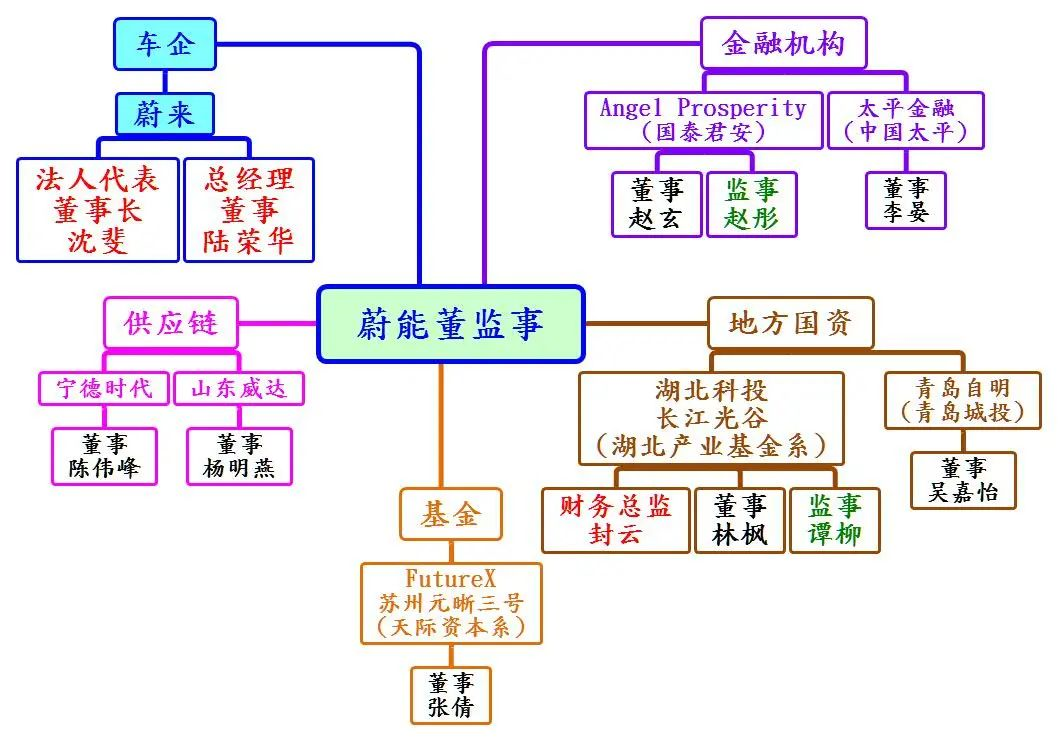
From the board structure, it can be seen that the directors of NIO Power are very scattered, and no one has absolute dominance. The supervisors are China Taiping and Hubei Capital Operation Management Group, which belongs to the CFO.
Although NIO has administrative control, the finance is managed by Hubei Capital Operation Management Group, and supervision is done by China Taiping and Hubei Capital Operation Management Group, and there is no need for cooperation between the two companies to help NIO in any fraudulent behavior, nor will other directors let it happen.
(It should be noted that Lu Ronghua no longer holds any position in NIO and works full-time at NIO Power.)
It can be said that the Grizzly accusation is baseless.
The Plotter
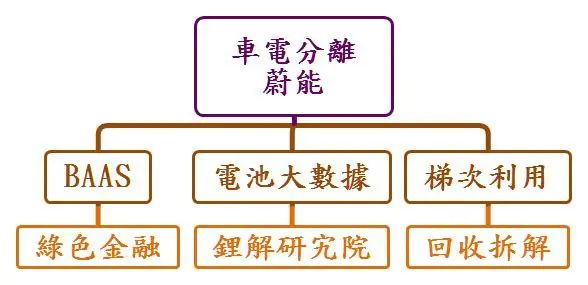
Why is the board structure of NIO Power so scattered?
This requires us to go back and talk about Li Bin’s business logic. What is the core of Li Bin’s business model?
The answer is “sharing.”
Li Bin said in a media interview after NIO Day 2020: “I always wanted to create an alliance back then, and spent a lot of time doing that, but later I realized that you have to act first, and be willing to open up to others to make it reasonable.“
What is a plotter?
It is a person who integrates different resources and creates and explores cooperative value between companies, and a strategic partner of companies. The plotter is the crystallization of Li Bin’s “sharing” concept.
NIO Power is a plotter for the new energy structure.
Before Shen Fei joined NIO, he answered Li Bin like this about battery swapping:
“The battery swapping station is a collection and storage energy point distributed in the city, which not only adds power to electric vehicle users, but also has a lot of imagination when combined with energy storage in the future.”# Shen Fei integrates battery swap into energy internet and considers the role of battery swap in new energy, coming to the conclusion that battery swap can serve as an alternative to energy storage.
Battery swap is a capital-intensive business model that cannot be sustained by a single automaker alone. Integration with the upstream and downstream industries, financial institutions, and government support is necessary, and NIO is taking on this role.
As a result, NIO’s shareholders include battery manufacturers, battery swap equipment suppliers, financial institutions, and local governments.
Originally, the first round of capital increase included Three Gorges Green Industry Fund (hereinafter referred to as “Three Gorges Fund”) and Honghua Comprehensive Electric Energy Investment Company (hereinafter referred to as “Honghua Comprehensive”).
The Three Gorges Fund is a government-led fund jointly established by Three Gorges Capital and Qingdao Haicong Group; Honghua Comprehensive is a subsidiary of Honghua Gas (now renamed Honghua Intelligent Energy).
Both are heavyweight players in new energy, with one managing hydro, wind, and solar power generation (China Three Gorges Corporation), and the other a natural gas pipeline service provider (Honghua Gas).
Both are actively investing in new energy and are indispensable parts of NIO’s new energy expansion.
However, both did not invest in NIO, so deeper cooperation was not possible.
Three Gorges Technology, a subsidiary of China Three Gorges Corporation, has chosen to join Yidong New Energy with FAW Group, Dongfeng Motor and Wuhan Economic Development Investment, aiming to become a digital intelligent energy service company, which was originally NIO’s vision.
Although NIO’s business scope includes the operation and management of new energy, electricity, and other energy-related industries, without guides, it is currently focused on the development of power batteries, its main business.
NIO Business
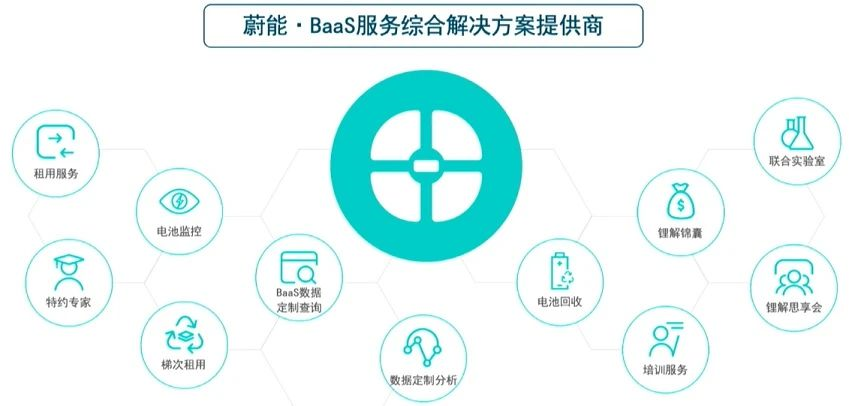
NIO defines itself as a provider of integrated solutions for BAAS services. Although the company has a small number of employees, 65% are technical personnel.
As an asset management company for batteries, the main assets are the batteries themselves and the big data generated by them, so 85% of NIO’s patents are related to battery technology, with the remaining 15% related to data intelligence.
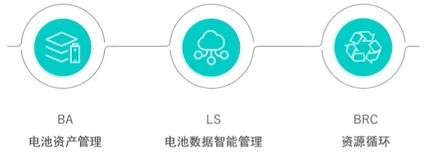
The dizzying array of businesses listed above can be broadly categorized into three types:- Battery Asset Management
- Intelligent Battery Data Management
- Resource Recycling
Let’s take a look at each one.
Battery Asset Management
Battery assets are the foundation of NIO’s survival. Without batteries, everything is meaningless.
BAAS, essentially, is a battery rental agreement.
Just like renting a house, the tenant only has the right to use the house, not the ownership; the car owner only has the right to use the battery, not the ownership.
Therefore, battery asset operation is similar to the model of building long-term rental apartments. It is a very capital-intensive business model, requires strong financial strength, and how to ensure continuous cash flow is the key to survival.
There are three sources of funds:
- Company equity and profits
NIO has gone through several rounds of capital increase, and the paid-in capital has expanded from the original 800 million to about 1.8 billion, which is suitable for initial capital, but facing the rapidly expanding NIO sales volume, this amount of capital is not enough.
BAAS’s battery recovery takes at least 6 years to break even and, coupled with personnel expenses, various research, taxes, and miscellaneous expenses, it is impossible to rely on profits to cover investment in the short term.
Therefore, the main way is still financial loans.
- Bank loans
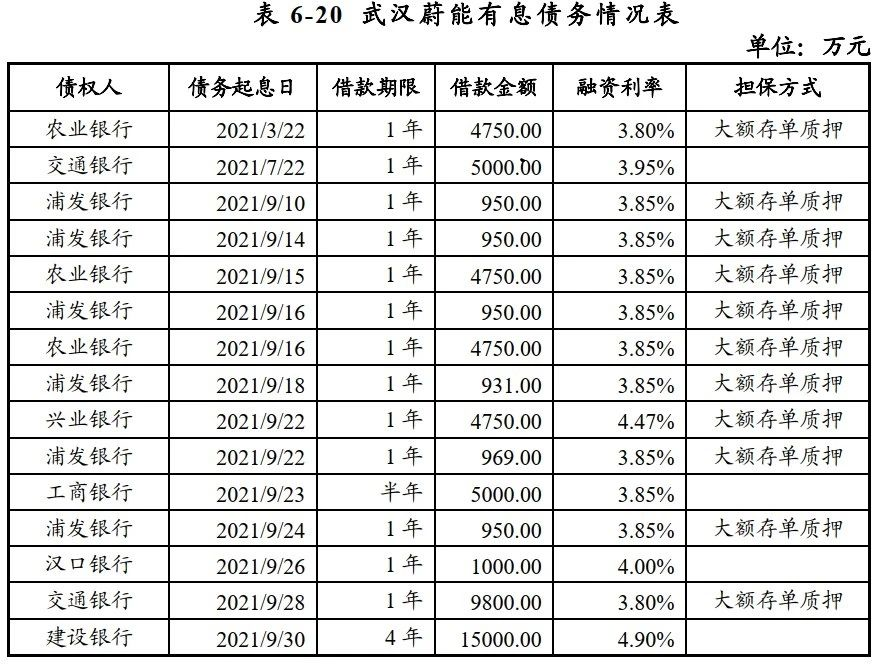
This is NIO’s main source of funding.
Taking the interest-bearing debt announced by NIO in 2021 as an example, the financing interest rates except for 4.9% from China Construction Bank and 4.47% from Industrial Bank, most of them are 3.85%.
Is this financing interest rate high or low?
Data released by the People’s Bank of China shows that the corporate loan interest rate for the whole year of 2021 was 4.61%, the lowest level since reform and opening up. It is usually difficult for general enterprises to obtain this kind of interest rate.
However, the interest rate on the money lent to NIO by the bank is 0.76% lower than the data released by the People’s Bank of China.
With a total loan balance of RMB 605 million at that time, the interest cost was reduced by approximately RMB 4 million, and the financing cost was so low that many companies were envious.
In addition to borrowing money from banks, since the BAAS model is similar to long-term rental apartments, can we securitize the rental income rights like long-term rental apartments?
The answer is: yes.
- Battery Asset Securitization
How to securitize battery assets?Weicai sells the rights to the returns of specific bond holdings within a certain period, colloquially known as “selling the rent of the batteries for a few years.”
Taking Weicai’s first Chinese green battery asset-backed note (ABN) as an example, it is the sale of the rights to the returns of 19,000 battery rents for 2 years.
NIO Finance is responsible for deducting the battery rent from the customers.
To prevent multiple sales of a single asset, the asset-backed securities collateral needs to be registered for collateral, the battery is mortgaged to China Investment Insurance, and Weicai provides counter-guarantee obligation for the remaining payable amount to China Investment Insurance.
If there is a problem with the non-conforming assets, Weicai will make up the difference and then initiate the guarantee. After fulfilling the guarantee responsibility, Weicai has the right to exercise the right of pledge to recover the compensation funds.
After NIO announced the possibility of buying out the battery-as-a-service (BAAS) in April 2022, some car owners chose to pay to buy out the BAAS, and the buyout fee will be paid to Weicai.
Again, it should be emphasized that Weicai is the owner of the battery assets, not NIO. Therefore, in the case of buying out the battery, the money is going to Weicai, and NIO is only the collecting party.
The ABN operation report published in November 2022 showed that 760 bonds have already been redeemed, and Weicai is responsible for the difference payment for the 14 bonds that are overdue for more than 90 days.
The amount issued for this ABN is CNY 400 million, and the issuance rate is 3.12%.
In addition, the first green battery asset-backed securities (ABS) issued have a total amount of CNY 635 million, divided into three levels with rates of 2.97%, 3.45%, and 3.76%, respectively.
Weicai is at the forefront of green finance innovation in China and even in the world.
Transforming heavy battery assets that might have dragged them down into financial commodities not only expands financing channels and scales but also optimizes costs to help develop green industries with the help of finance.
Battery Data Intelligence Management
Weicai is a battery asset management company. How to maximize the efficiency of battery assets?
It will be reflected in the operating capacity of the company.
Weicai’s understanding of the ladder utilization is different from that of most peers. There is always value in the incremental use of power batteries, but the maximum value of the power batteries must be realized in the on-board stage.The following is the English Markdown text with HTML tags preserved.
Wen Energy’s Lithium Dissolution Research Institute
The lithium dissolution research institute of Wen Energy, through big data analysis, studies the entire lifecycle management and application of power batteries. Since the period of the maximum value of power batteries is when they are used in vehicles, the key to extending their lifespan is to know how to prolong their life while being used in vehicles.
The first step is to ensure good the SOH (State of Health) estimation of the batteries.
The next step is to study the technology of battery stress balance, which affects the lifespan and safety of the batteries. The lifespan of battery is determined by its weakest core. The more balance the state of the core is, the longer the battery’s lifespan will be.
The primary purpose of studying battery stress is to study lithium dissolution reactions.
The dissolution of lithium in the core will not only cause a decrease in battery performance and a significant reduction in its cycle life, but also limit the battery’s fast charging capacity and can possibly lead to thermal runaway.
Wen Energy collects and monitors battery data from vehicles or battery swap stations and calculates the deviation of the battery’s voltage. When the deviation becomes significant, they trigger the calculation of the voltage change trend, and then judge whether lithium dissolution is occurring based on the voltage decline rate.
By analyzing the type, model, and usage of batteries through AI algorithms, they can determine the optimal use mode of the battery and guide the configuration strategy of different battery swap stations.
Based on the collected data, they can determine whether the battery meets safety regulations and actively replace those that do not comply to ensure the safety of the batteries.
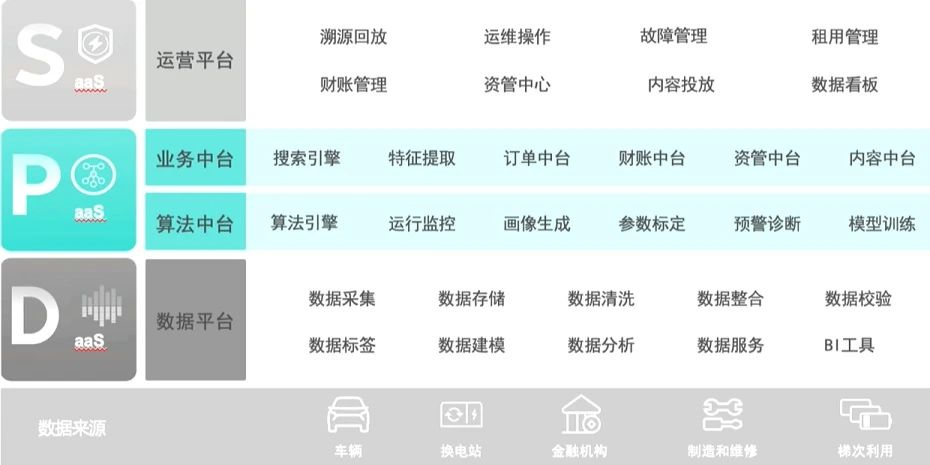
In July 2022, Wen Energy signed multiple contracts for its BAAS service with companies in commercial vehicle battery-swapping, insurance and financial services, and car data services.
The commercial vehicle battery-swapping cooperation is with several companies, including Jianghuai Motor’s Sihao New Energy and Zeqing New Energy, Beiqi Foton’s Yangguang Mingdao, and Geely’s Yinlong Mingdao. Wen Energy provides battery multi-scenario operating data and together they create safe and reliable cloud management solutions and battery valuation systems.
Wen Energy also partnered with ZhongYin YunChuang to develop the Intelligent Financing System (IFS) which provides digital and intelligent services for BAAS funds and risk management.
In addition, Wen Energy has established a joint laboratory with Dinghe Insurance, Zhongbao Institute, and China Automobile Data. According to the needs of insurance, they explore innovative business models and strategic cooperation in areas such as battery depreciation rate and residual value estimation, risk assessment, and safety monitoring.
 The most intuitive manifestation of collaboration is the WeChat Mini Program “LiJie” launched by Weilan Power. General users can use “LiJie” to learn about industry dynamics, news, and related research results of electric vehicles and batteries. For example, the LPI (Lithium-ion Battery Raw Material Price Index) in the LiJie data is the price of the main raw material of the lithium battery. Through big data analysis and intelligent calculation upstream and downstream of the industry, various weights are reflected by using LiJie AI, which shows the changes in the price of lithium battery raw materials.
The most intuitive manifestation of collaboration is the WeChat Mini Program “LiJie” launched by Weilan Power. General users can use “LiJie” to learn about industry dynamics, news, and related research results of electric vehicles and batteries. For example, the LPI (Lithium-ion Battery Raw Material Price Index) in the LiJie data is the price of the main raw material of the lithium battery. Through big data analysis and intelligent calculation upstream and downstream of the industry, various weights are reflected by using LiJie AI, which shows the changes in the price of lithium battery raw materials.
This data can better reflect the cost of lithium battery raw materials than simply looking at the price of lithium carbonate. After all, the cost of a battery is not only affected by the price of lithium carbonate. Otherwise, although the price of lithium carbonate in 2022 has increased tenfold compared to that of 2020, the cost of battery raw materials has not skyrocketed by ten times, but by only about six times.
For practitioners related to electric vehicles, there can be a basis for knowing whether the cost provided by the battery factory is reasonable. LiJie’s weekly index report speaks with data, short commentary on nickel, cobalt, and lithium can provide investors in raw materials with a quick understanding of the short-term impact factors of these three.
For cooperative enterprises, Weilan’s enterprise battery service can achieve a more accurate battery assessment, which can make the actual battery failure alarm rate exceed 95%, the battery SOH accuracy within plus or minus 1%, and increase the battery service life by 25%.
The development of LiJie Research Institute and the signing of BAAS service symbolize Weilan’s battery management technology empowering the electrification market. It not only serves NIO but also contributes to innovative business development for commercial vehicle battery exchange and battery and insurance.
Resource recycling: When the power battery becomes unsuitable for on-board installation and is retired, if there is residual value, it can be used in steps. The stepwise utilization can be divided into dismantlement and reorganization and whole-pack utilization. Dismantlement and reorganization require additional resource investment. The advantage is that it has high flexibility and can be applied to more scenes. Whole-pack utilization refers to checking without dismantling the pack and directly applying it to a new scene after it is qualified. The advantage is high cost-effectiveness.At the beginning of NIO’s plan, due to the immaturity of battery manufacturing technology and the large individual differences of battery cells at that time, disassembly and reassembly was the main method.
However, the battery manufacturing technology is now quite mature and the individual differences of battery cells are small, so there is a tendency to use the entire battery pack.
According to NIO’s patent CN113054266A, when the SOH value of the battery pack exceeds 80%, it can be used for commercial electric vehicles, and when the SOH value is between 70% and 80%, it can be used for communication base stations or microgrid energy storage.
The ownership of the battery pack belongs to NIO Energy, so the adopted method is to rent the entire battery pack, called “laddered rental”.
NIO Energy collects the rent and is responsible for the health of the battery pack.
The biggest problem with battery pack laddering is “safety”. NIO Energy has big data on the batteries and can achieve real-time monitoring. Once any safety concerns are found, NIO Energy will notify the owner to recover the battery pack, so that the lessee can use it safely and confidently.
When the battery pack reaches the end of its lifespan, NIO Energy has a huge advantage over other battery recycling companies because NIO uses uniform battery pack sizes and single cell encapsulation standards due to the battery swapping system. This allows for mass recycling of batteries of the same batch and allows for the establishment of an automated disassembly production line, which reduces costs and increases efficiency.
NIO Energy is currently investing a lot of effort in the recovery of positive electrode materials, producing “non-extraction regenerated powder” through material repair technology. The process can be seen in the patent CN115020854A jointly published by NIO Energy and Huazhong University of Science and Technology.
Step one:
Disassemble retired battery packs to obtain positive and negative electrode plates, including current collecting fluid and electrode material layers closely attached to the current collecting fluid.
Step two:
Soak the electrode plates in a specific solution that separates the electrode material from the current collecting fluid.
Step three:
Inject gas into the solution to accelerate the separation of the electrode material and current collecting fluid.On the basis of liquid-liquid separation using the interaction of polyethylene terephthalate (PET) film and solution, the separation efficiency is significantly improved by accelerating the separation of electrode materials and collectors through gas turbulence. Moreover, the introduced gas can dilute harmful gases in the separation process, avoid the risk of harmful gases and improve operational safety.
This is just one of the patents for separating battery materials, which is now transitioning from the laboratory to industrial production, allowing battery assets to be efficiently recovered and regenerated, continuously injecting them into the battery industry chain.
In summary, according to the current industry’s recycling technology for power batteries, the material recovery capacity can reach an average of 85%, or even higher. This means that the more cars that NIO sells, the more battery assets it possesses, and the lower the cost of battery recovery, because it does not need to bear the additional cost of third-party battery recovery.
Simply put, NIO is like an invisible mining company.
Conclusion
Especially at a time when countries around the world are trying to secure battery raw materials, China’s reliance on foreign battery raw materials has become not just an economic issue but a security one.
When the transportation system shifts from fuel-intensive consumption to material-intensive circular performance energy, someone said that lithium is the white oil of the new energy era and the lifeblood of the battery. But lithium is not like oil, which is gone once it’s burned. It is a recyclable and renewable resource.
As NIO’s sales increase, it holds more and more batteries, just as Lü Ronghua said: “We are managing a mine, but the ore is distributed in electric vehicles throughout the country.”
The battery is that mine, and how to improve the rate of battery recovery and utilization is a question that NIO has been contemplating.
This is not only about economic efficiency, but also about security.
This article is a translation by ChatGPT of a Chinese report from 42HOW. If you have any questions about it, please email bd@42how.com.
